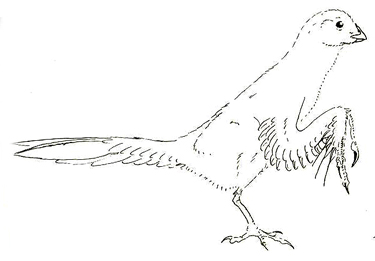

The false panha (Pseudoraptor apates) is one of the strangest birds imaginable, an aberrant enantiornithian with the claws of a pithecosaur, the hips of a true bird, and poisonous feathers like no other creature in existence.For such an enigmatic animal, false panhas lead rather quite lives in the highland bamboo forests of central Asia. Flightless false panhas clamber nimbly through the stalks, nipping off new shoots where they sprout from the main stem. A false panha's stubby beak is quite sharp, and the tiny teeth near the back of the upper mandible give these creatures an extra grip on their food. False panhas dine almost exclusively on bamboo (though young specimens have been seen on the ground digging for invertebrates) and consequently possess large stomachs which rest on the curious, swept-back hips and are held in by a series of gastralia.
Perhaps the strangest feature of the false panha is the poison glands that develop on the males as they approach adulthood. In females, glands situated under and along their arms produce a musky preening oil, but in the males' glands secrete a skin irritant. The males rub this secretion over their own bodies and the bodies of their mates and chicks during regular preening sessions. Also and of itself, the oil drips down a series of channeled feathers and into sharp quills at the base of the hands, making formidable weapons that the males use in defense of their families and in dominance battles. While predators that bite down on a poison-coated false-panha receive an uncomfortable rash, attackers that have received a swipe from the sharp claws and poisoned quills of a male false-panha soon find themselves writhing in agony as the poison is delivered directly into their blood stream.
False panhas live in closely-knit troupes of females and juveniles led by a single dominant male. Young males leave the troupe upon reaching puberty and form "bachelor troupes" that attempt to usurp the territory and females of older males. Only during dominance battles do these normally placid herbivores become violent, slashing at each other with powerful beaks and poison-tipped quills. Challengers are usually defeated by the males already in place (these males having grown quite large during their reigns), but if an old male is defeated, the young one systematically kills all of his predecessor's chicks and mates with the females, assuring the transmission of his own genes rather than those of another. Once in control of a troupe, male false panhas grow enormously until they weigh half again as much as the females. They also develop prominent wattles around the face and neck while their skin flushes red.